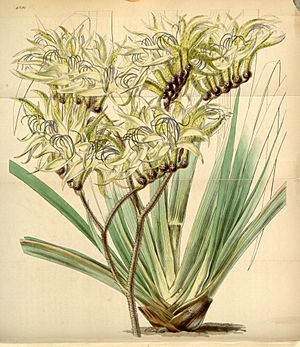Macropidia facts for kids
Quick facts for kids Macropidia |
|
|---|---|
 |
|
| Macropidia fuliginosa | |
| Scientific classification | |
| Genus: |
Macropidia
|
| Species: |
fuliginosa
|
The black kangaroo paw, known scientifically as Macropidia fuliginosa, is a unique flowering plant. It's the only species in its group, called Macropidia. This plant grows year after year and has a special underground stem called a rhizome. You can only find the black kangaroo paw in Southwest Australia, mainly from Perth up to Geraldton.
Description
The black kangaroo paw is a small plant that grows back every year. It has green-yellow leaves that stand upright, reaching between 0.2 and 1.8 metres tall. The leaves look like straps, about 20 to 50 centimetres long, and grow close together near the ground.
How it Reproduces and Survives
These plants grow from a special underground stem called a rhizome. This rhizome helps the plant regrow even after a bushfire. Flowers appear in spring and summer on branched stems that can be a metre or more tall. The flowers and stems are covered in black hairs, which gives the plant its name.
Birds help to pollinate the black kangaroo paw. Some of these birds include:
- Spiny-cheeked honeyeater
- Singing honeyeater
- Brown honeyeater
- Tawny-crowned honeyeater
- White-cheeked honeyeater
- Red wattlebird
While you can grow this plant from seeds, most commercial growers use a method called tissue culture to make more plants. The black kangaroo paw is not as common in gardens as other types of kangaroo paws from the Anigozanthos group. This is because other types are tougher and easier to grow.
Good news! The black kangaroo paw is currently listed as 'not threatened' in Western Australia.
What's in a Name?
The name "kangaroo paw" comes from how the flowering branches look a bit like a kangaroo's forearm. This specific "black" species is the only one in its group, Macropidia. There are eleven other similar plants, but they belong to a different group called Anigozanthos.
The scientific name Macropidia is related to the kangaroo group Macropus. The second part, fuliginosa, comes from the Latin word for soot, fuligo. This refers to the plant's black colour. When the plant was first described in the Botanical Magazine in 1847, it was sometimes called the "sooty anigozanthos."
The Aboriginal word for the black kangaroo paw is "Nollamara." This word was also given to a suburb in Perth.
Staying Healthy
If the black kangaroo paw gets sick, you can cut it back to the ground. It will then regrow from its underground rhizome. Like many native Australian plants, it can survive bushfires in the wild. However, it can sometimes get fungal diseases, like ink-spot fungus or rust fungus.


